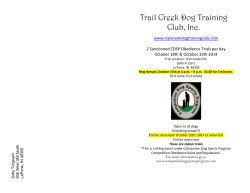
D Teaching Children to Respect Dogs #49 SAFETY DOS AND DON’TS
#49 Teaching Children to Respect Dogs D ogs can make loving, gentle pets. Through simply knowing a dog in the neighbourhood, children can learn about empathy and caring for others. But whether it’s your own family dog, a neighbour’s or a stray, dogs can cause harm under certain situations. Children — especially those nine and under — are most at risk of dog-bite injury causing serious physical and long-term emotional trauma. Teaching children to respect pets is the first step in guarding against bites from dogs. SAFETY DOS AND DON’TS Teach children to observe the simple rules of safe and considerate behaviour around dogs — their own and others. Don’t l l l Why do dogs bite? Most dogs are safe, reliable companions, but even a friendly dog may bite if threatened, angry, afraid or hurt. Some dogs who are trained to be aggressive may chase and attack a fleeing child. Dogs are generally protective of their food, puppies or toys. They may also be protective of their spaces and owners. Commonly defended places include eating and sleeping areas, yards, porches and parked cars. A child reaching through a fence or arriving unexpectedly at the door can turn a neighbour’s warm, loyal pet into a growling, aggressive protector. Children must learn not to frighten or anger a dog. Other Reasons Dogs May Bite l l l l l Cornering, crowding or standing over a dog (particularly a small one) may make him feel defensive. Children should stand back and never put their faces close to a dog’s mouth. Stray dogs may be very dangerous. Any dog that is loose may be lost, frightened or injured and therefore more likely to bite. Sick or injured dogs may be afraid or irritable. Elderly dogs may have impaired vision or hearing which can cause them to be more easily startled. A dog that is excited or nervous may bite by mistake. Dogs can feel left out, especially when a new baby or pet joins the household. Give a dog extra love and attention when this happens. l l l l l Do l l l l Dogs living with or around children need to be able to tolerate a degree of rough treatment without resorting to biting. Children should only be around dogs that don’t “play bite” and family pets should be chosen carefully with this in mind. Small children and very young puppies are not suitable companions. A toddler sees the puppy as a cuddly toy to be pushed and poked, and a puppy might nip in defence. In the end, the child may grow up afraid of dogs or the puppy may mature into a nervous, irritable dog. An older pup, about 12 months of age, is much more suitable for young children. Never leave an infant or young child alone with a dog. tease dogs (pull tail or ears, throw things at, ride or chase them), even dogs behind fences; go near dogs chained or tied up in yards; touch or play with a dog while he is eating; touch or scare a dog while he is sleeping; approach or touch a dog that is on the loose; run and scream if a dog comes near you; stare into a dog’s eyes; take a dog’s toys or bones away from him. l l ask the owner if it’s okay before petting a dog; let a dog sniff your closed hand before petting him; tell an adult right away if you see a stray, injured or scary looking dog; stand very still (like a tree) and be very quiet if a dog comes near you; lie face down (like a log) and cover the back of your neck if a dog attacks you; act kindly and gently towards dogs and other animals. Adapted by Sherry Scharff from materials provided by the American Society for the Prevention of Cruelty to Animals and “Bite Free,” a brochure distributed by The Humane Society of OttawaCarleton. For more information on dog bites and humane education, contact your local Humane Society. Permission is not required to make photocopies of this resource sheet for public education purposes. Photocopies may not be sold. To purchase or reprint this resource sheet, contact the Canadian Child Care Federation, 383 Parkdale Avenue, Suite 201, Ottawa, Ontario, K1Y 4R4. Tel 1 800 858-1412 or (613) 729-5289. Fax (613) 729-3159. Email cccf@cfc-efc.ca. © CCCF 2001
© Copyright 2025





















